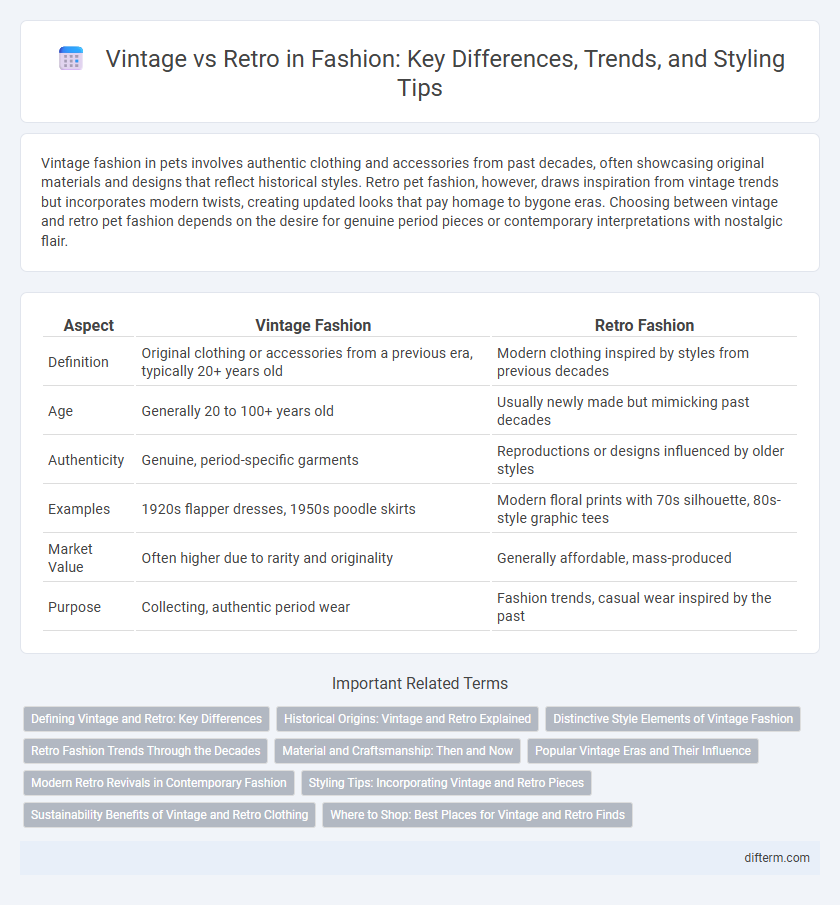Vintage fashion in pets involves authentic clothing and accessories from past decades, often showcasing original materials and designs that reflect historical styles. Retro pet fashion, however, draws inspiration from vintage trends but incorporates modern twists, creating updated looks that pay homage to bygone eras. Choosing between vintage and retro pet fashion depends on the desire for genuine period pieces or contemporary interpretations with nostalgic flair.
Table of Comparison
| Aspect | Vintage Fashion | Retro Fashion |
|---|---|---|
| Definition | Original clothing or accessories from a previous era, typically 20+ years old | Modern clothing inspired by styles from previous decades |
| Age | Generally 20 to 100+ years old | Usually newly made but mimicking past decades |
| Authenticity | Genuine, period-specific garments | Reproductions or designs influenced by older styles |
| Examples | 1920s flapper dresses, 1950s poodle skirts | Modern floral prints with 70s silhouette, 80s-style graphic tees |
| Market Value | Often higher due to rarity and originality | Generally affordable, mass-produced |
| Purpose | Collecting, authentic period wear | Fashion trends, casual wear inspired by the past |
Defining Vintage and Retro: Key Differences
Vintage fashion refers to authentic clothing and accessories originating from previous decades, typically items that are at least 20 to 30 years old, embodying the style and fabric of their era. Retro fashion, by contrast, involves contemporary garments designed to imitate or evoke the aesthetics of past trends without being original pieces from those periods. Key differences include authenticity and age, where vintage constitutes genuine historical items, whereas retro encompasses modern reproductions inspired by vintage looks.
Historical Origins: Vintage and Retro Explained
Vintage fashion refers to authentic clothing and accessories originating from a specific era, typically at least 20 to 30 years old, reflecting the genuine styles and cultural trends of that time. Retro fashion, by contrast, replicates or is inspired by styles from past decades but is newly produced, often blending nostalgic elements with modern twists. The historical origins of vintage lie in preserving original garments from the early to mid-20th century, while retro emerged as a revival trend from the late 20th century onward, celebrating iconic aesthetics with contemporary reinterpretation.
Distinctive Style Elements of Vintage Fashion
Vintage fashion is characterized by authentic garments originating from a specific era, often showcasing unique craftsmanship, high-quality materials, and period-specific silhouettes such as flared skirts, structured shoulders, and intricate embroidery. Distinctive style elements include authentic wear patterns, original fabrics like silk and wool, and design details reflecting historical trends from the 1920s to the 1980s. These elements distinguish vintage pieces from retro fashion, which replicates past styles rather than preserving genuine vintage garments.
Retro Fashion Trends Through the Decades
Retro fashion trends capture iconic styles from the 1950s through the 1990s, emphasizing bold patterns, vibrant colors, and distinctive silhouettes. Key elements include 70s disco-inspired flared pants, 80s power suits with shoulder pads, and 90s grunge featuring distressed denim and oversized flannel shirts. These trends continually resurface in modern collections, blending nostalgia with contemporary aesthetics.
Material and Craftsmanship: Then and Now
Vintage fashion boasts authentic materials like natural fibers, handwoven fabrics, and intricate craftsmanship reflecting labor-intensive techniques from past eras. Retro fashion often replicates these styles using modern synthetic fabrics and mass-production methods, sacrificing some texture and durability for affordability and accessibility. The evolution from handcrafted garments to machine-made textiles highlights the contrast in material quality and artisanal detail between vintage originals and retro-inspired pieces.
Popular Vintage Eras and Their Influence
Popular vintage fashion eras such as the Roaring Twenties, the 1950s rockabilly, and the 1970s disco have profoundly shaped contemporary styles with their distinctive silhouettes, fabrics, and cultural aesthetics. Designers often draw inspiration from these periods to create collections that evoke nostalgia while blending modern trends. The enduring appeal of vintage fashion lies in its authentic craftsmanship and timeless designs, contrasting with retro styles that replicate or reinterpret past looks with contemporary twists.
Modern Retro Revivals in Contemporary Fashion
Modern retro revivals in contemporary fashion draw inspiration from iconic styles of past decades, blending vintage aesthetics with current trends to create a fresh yet nostalgic look. Designers are reinterpreting classic silhouettes, fabrics, and patterns from the 60s, 70s, and 80s with modern tailoring and sustainable materials to appeal to today's eco-conscious consumers. This fusion of vintage charm and innovative design drives the resurgence of retro-inspired collections in global fashion markets.
Styling Tips: Incorporating Vintage and Retro Pieces
Incorporate vintage pieces by focusing on authentic fabrics and classic silhouettes like A-line skirts and tailored blazers, ensuring a timeless elegance in your outfit. Retro styling thrives with bold patterns, vibrant colors, and statement accessories, such as oversized sunglasses and chunky jewelry, capturing the essence of past decades with a modern twist. Mixing vintage and retro elements requires balancing subtlety and flair, pairing key statement items with contemporary basics to create a cohesive and stylish look.
Sustainability Benefits of Vintage and Retro Clothing
Vintage clothing, typically items over 20 years old, offers significant sustainability benefits by reducing waste and minimizing the environmental impact of textile production. Retro fashion, inspired by past styles but newly produced, also contributes to sustainability when created using eco-friendly materials and ethical manufacturing practices. Choosing vintage and retro pieces supports a circular fashion economy, extending garment life cycles and promoting resource conservation.
Where to Shop: Best Places for Vintage and Retro Finds
Top destinations for vintage fashion include specialized boutiques, thrift stores, and online marketplaces like Etsy and Depop, known for authentic, one-of-a-kind pieces from past decades. Retro fashion, often inspired by vintage styles but newly made, can be found in mainstream retailers and specialty shops such as Beyond Retro and Rokit. Marketplaces like eBay offer a mix of vintage and retro items, making them ideal for diverse style seekers aiming for authenticity and unique flair.
Vintage vs retro (fashion context) Infographic

 difterm.com
difterm.com